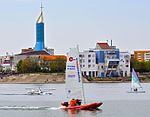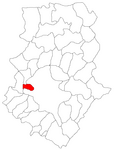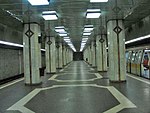Militari is a district in the western part of Bucharest, in Sector 6. It is home to more than 100,000 inhabitants.
In the past a village called "Militari" existed here, but today there are only few houses left from that time.
The earliest housing scheme comprises small, semi-detached houses, which have been built in the 1950s by Communist party workers, with the first tower blocks being built in 1966–1967. Later, in the 1970s and 1980s, most of the present-day blocks of flats (with 8 and 10 floors) were built. Amongst the well-known apartment buildings are the B22 Block, built from 1977 to 1979 by Yugoslav architects, the 15-storey tower blocks at Lujerului (right next to the so-called Serbian block, also designed by Yugoslav architects, completed in 1974), and the OD16 block, initially built sometime between 1972 and 1975, but fully collapsed during the 1977 Vrancea earthquake due to substandard construction practices (it was eventually rebuilt in 1978). The neighborhood features a few markets, including Gorjului, Lujerului, and Apusului (similar markets are found in most communist-era housing estates, such as the Sălăjan market in Titan, as well as the Moghioroș and Orizont markets in Drumul Taberei).The district is very compact and it was built using a basic three parallel boulevards geometry. Militari is packed between Drumul Taberei and Crângași districts, and it is one of the westernmost neighborhoods of Bucharest. It is served by the Bucharest Metro, buses, trolleybuses, and tramways which connect it with the city center and the Gara de Nord railway station.
Because of its access to the A1 motorway, the district developed rapidly following the Romanian Revolution of 1989, transforming itself in one of the most prosperous neighborhoods of Bucharest. In recent years the district saw the opening of two hypermarkets (Cora and Carrefour), and a large mall ("Plaza Romania"). The district has a new theatre ("Masca") and a modern cinema ("Movieplex").









